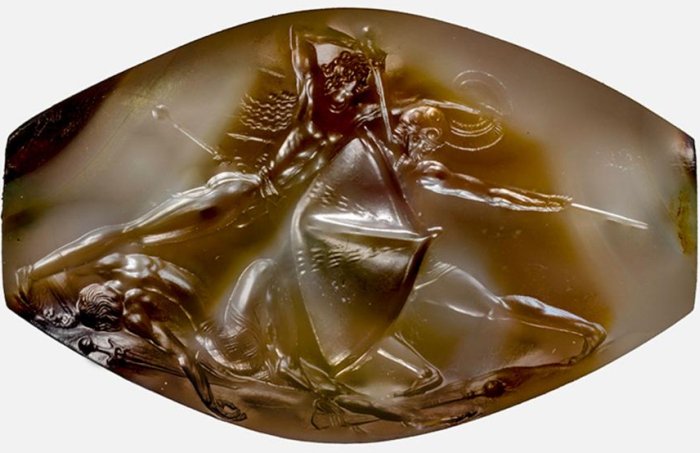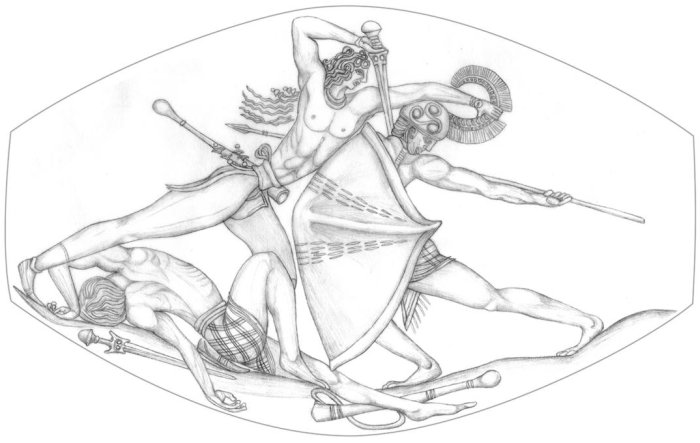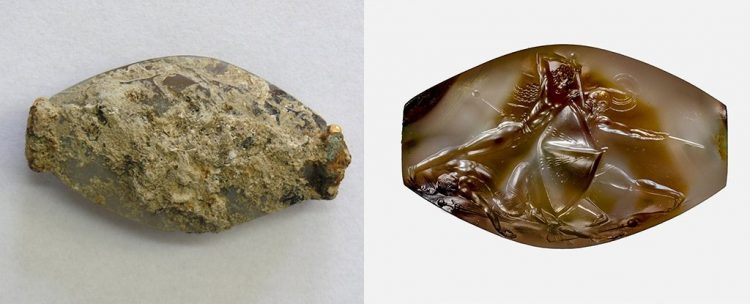In 2015 researchers from the University of Cincinnati uncovered a Bronze Age tomb in Pylos, in southwest Greece. It belonged to the so-called ‘Griffin Warrior’, a wealthy Mycenaean man, and dates back 3,500 years. Inside archaeologists uncovered a trove of treasure including precious jewels, armor and weapons, and many vessels made from precious metals. One of the most exciting discoveries, however, came in the form of a seemingly insignificant agate stone. It was covered in limestone initially, and it took a year of careful restoration to reveal its true form.
What lay beneath the limestone is a discovery so astounding that it is set to rewrite art history. As the intricate details of the stone’s design began to emerge, the researchers were astonished to discover that they had unearthed a masterpiece. The agate stone was revealed to be a seal, used for stamping an image onto clay or wax. The seal, named the ‘Pylos Combat Agate’, depicts a fierce hand-to-hand battle between tho warriors, with a third one already crumpled on the ground. The scene was meticulously carved on a 3.6-centimetre piece of hard stone, and some of the details are only half a millimeter in size.

Photo: University of Cincinnati
Jack Davis, professor of Greek archaeology at the University of Cincinnati , said of the seal, “What is fascinating is that the representation of the human body is at a level of detail and musculature that one doesn’t find again until the classical period of Greek art 1,000 years later. It’s a spectacular find.”
“Some of the details on this are only a half-millimeter big, they’re incomprehensibly small,” Davis added.
The seal is set to rewrite the modern understanding of art history, and the development of Greek art, as the skill and craftsmanship are unparalleled by any previous Bronze Age discovery, with many details only visible under a magnifying glass. How ancient craftspeople were able to accomplish this without modern tools has mystified researchers, and they say that the discovery prompts a reconsideration of the evolution and development of Greek art.

Photo: University of Cincinnati
“This seal should be included in all forthcoming art history texts, and will change the way that prehistoric art is viewed,” said Shari Stocker, a senior research associate in University of Cincinnati’s Department of Classics.
Meanwhile, work continues in unearthing the Griffin Warrior’s tomb. Over 3000 burial objects have been discovered in the grave, including gold rings, silver cups, a sword with gold embroidery on the pommel, over 1,000 beads carved from precious stones, a suit of bronze armor, ivory combs, a gold necklace, and over 50 seal stones. The discoveries have been cataloged by Davis and Stocker, along with other UC staff and students. Some items are still in the process of being cleaned and preserved.
“There will be many more surprises to come, for sure,” said Davis.

Photo: University of Cincinnati
A full analysis of the Pylos Combat Agate will be published by Stocker and Davis in the journal Hesperia.**






